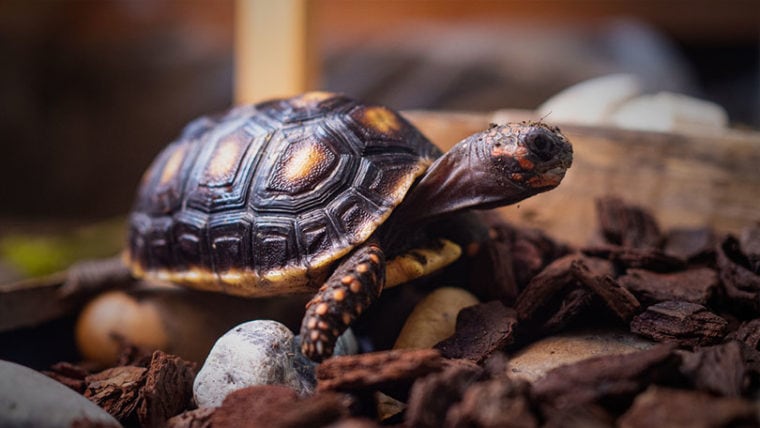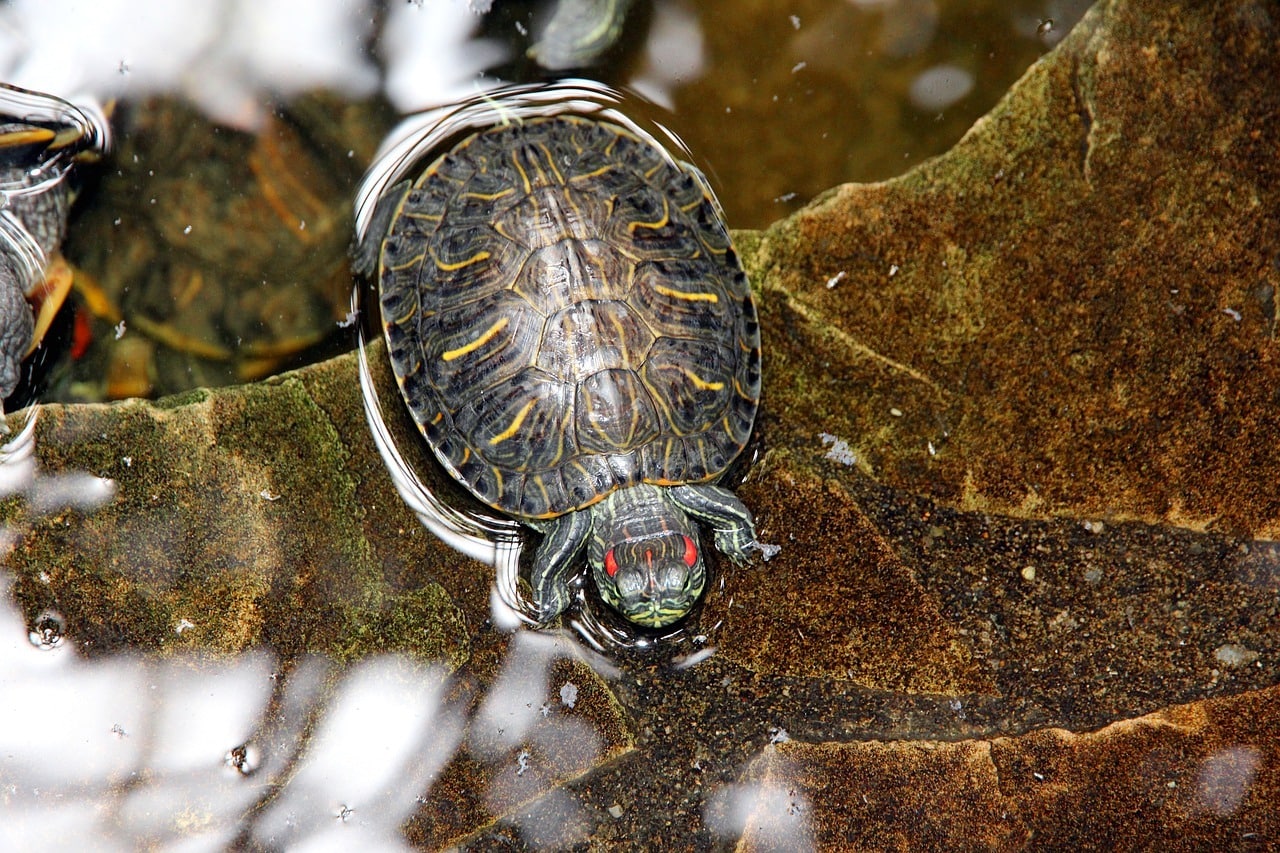
Building your tortoise habitat is a totally doable and rewarding task. Unfortunately, many commercial tortoise enclosures aren’t made to fully support your pet’s needs, so many tortoise owners opt to build their own.
A tortoise table is the perfect indoor accommodation for your tortoise. They differ from reptile enclosures like terrariums or vivariums as they are not enclosed. Most people keep their tortoise tables with a fully open top or a mesh screen. It’s essential to keep fresh air flowing in your pet’s habitat unless you have a tropical tortoise that prefers a humid environment.
Keep reading to find the six best tortoise table plans you can whip up today.
The 6 DIY Tortoise Tables
1. Reclaimed Dresser Tortoise Table
| Materials: | Old dresser, glass |
| Tools: | Saw |
| Difficulty Level: | Easy |
This reclaimed dresser tortoise table is perhaps the easiest DIY on our list. The original creator of this actually built the entire dresser from scratch, which would be substantially more difficult. But we thought it would be pretty easy to get the same effect with an old dresser.
If you have an older dresser kicking around your home or found one someone was giving away for free, you can have your very own tortoise table in just a few steps.
You’ll need a saw to cut a rectangular hole in the top of the dresser and may need to have a piece of glass custom-made to fit into this hole. Alternatively, you can find a piece of glass and cut the hole in the dresser top to fit it.
How you configure the dresser will depend on your needs and the dresser layout. You can leave the bottom drawers for supplies, saving the top drawers for the tortoise habitat. However, you may need to reconfigure the top drawers to make them work for you.
2. Grid Cage Table

| Materials: | Coroplast, grid panels, panel connectors |
| Tools: | N/A |
| Difficulty Level: | Easy |
This grid cage table is another super simple DIY you can whip together in less than an hour. You can find the grid panels in department stores like Walmart or even online on Amazon. The panels will come with connectors so you can design your grid table to suit your needs.
We recommend buying more panels that you think are necessary. It’s surprising how quickly you’ll use every panel, especially when building “legs” for the table and a light fixture hanger from them.
Once you have your grids set up in the configuration you desire, you’ll need to build a base for inside the table. Coroplast is corrugated plastic sheeting that you can find at your local hardware store. You will need to cut it to fit inside the habitat area. Once the base is set, cut pieces of the coroplast to act as side guards for the cage.
3. Plywood Tortoise Table

| Materials: | Plywood, screws, wood beams |
| Tools: | Saw, drill |
| Difficulty Level: | Moderate |
You’ll need to be at least moderately comfortable with power tools to tackle this plywood tortoise table. The original creator’s table is a bit bland, but we think you could spice it up and make it a bit nicer by decorating the sides of the plywood with tortoise-safe paint or even pieces of scrapbook paper. Your final project doesn’t need to look quite as plain as the original creators.
4. Reclaimed Bookshelf Tortoise Table

| Materials: | Old bookshelf, plywood, adhesive, vinyl flooring, silicone caulking or duct tape, tub, screws, sealant |
| Tools: | Saw, belt sander, drill |
| Difficulty Level: | Moderate |
This reclaimed bookshelf table is a bit more labor intensive than some of the other projects, but the end result is lovely. The creator used an old bookshelf they found on Craigslist and scraps of plywood and vinyl flooring they had lying around to save money.
They wanted their pets to have space to dig deeper, so they cut a hole in the back of the bookshelf to attach a plastic tub. They then needed to craft some legs for their table, which they made from the shelves that came in the bookshelf. You might also consider adding an additional leg to provide extra support. If you don’t want your table to have an area for deeper digging, you can skip those steps altogether.
They used the vinyl flooring from their attic as the base of their table and a sealant to prevent the wood of the bookshelf from moisture.
5. Planter Box Tortoise Table

| Materials: | Planter box |
| Tools: | Tools required to assemble planter box |
| Difficulty Level: | Easy |
Tortoise tables don’t have to be an eyesore that only takes away from your home’s aesthetic. This DIY is made with a store-bought freestanding planter to add a little style to your space. Converting this planter into a tortoise table is simple. Partially fill your planter with dirt and cover with mulch or whatever substrate your pet likes. Next, attach your light fixture to the back wall of the planter, and voila.
6. Pallet Tortoise Table

| Materials: | Wood pallets, caulking, plastic pot tray, indoor/outdoor carpet, screws |
| Tools: | Saw, drill, caulk gun |
| Difficulty Level: | Hard |
This wooden tortoise table is made from wood pallets. You can usually find pallets for free at local hardware stores, furniture stores, or even construction sites to help cut down on the costs for this project. You’ll need to know your way around power tools to finish this DIY successfully, but we think it’ll be worth the effort.
You can tweak this project to suit your exact needs. For example, the original creators cut down pallets to form the base of their enclosure to make it 2′ by 3′. So if you want your table larger or smaller, you can do so by making the appropriate cuts.
How Big Should My Tortoise Table Be?
Before you work on your project, you must decide on the proper dimensions for your tortoise table. The size of your table will ultimately depend on the size of your tortoise. The bigger you can make it, the better it’ll be and the happier your tortoise will be. We wouldn’t recommend building anything smaller than 3′ by 2′.
Be sure to keep the sides of the enclosure high enough to prevent your tortoise from escaping. We recommend the sides be at least eight inches taller than the substrate.
Where Should I Put My Tortoise Table?
Once your project is complete, your next task is to decide where your tortoise table should live in your home. We recommend choosing a bright area of your home but one that’s not in direct sunlight. It should be free from drafts and near an outlet so you can plug in your tortoise’s lights.
The room you choose should have a consistent temperature. Don’t let the temp drop below 72–75°F, as your tortoise needs constant access to heat. Some people suggest the air temperature should be around 85-90°F.
Your tortoise would appreciate being in a quieter place in your home where it can live its life free from the never-ending attention of small children or other pets. A quiet space can keep stress levels to a minimum and make your tortoise happier overall.
What Should I Put In My Tortoise Table?
Since your table has an open-top design, regulating the precise temperature your tortoise needs can be challenging. A daytime heat light is a must-have for any tortoise habitat. We like this 60W lamp from Exo Terra as it can help ensure your tortoise gets the UVA light it needs to help with digestion and stimulate activity.
You’ll also want a thermometer to monitor the temperature at all times. We like this analog option from Exo Terra.
UVB lighting is another essential you’ll need in your tortoise table so they can produce vitamin D3 to keep their shell and bones healthy. Unfortunately, your tortoise will not get all the UVB light it needs to thrive just from living in a sunny room.
Don’t forget a lamp stand to keep your reptile’s lighting system neat and orderly.
Substrate is a must-have to line the bottom of your table. You have a few options, such as pellet bedding, aspen, or sterilized topsoil. Zoo Med’s ReptiSoil is one of our favorite substrates as it’s great for digging and growing plants. We also recommend lining the entire enclosure with thick plastic beforehand to prevent any seeping of water or substrate.
Your tortoise needs a hiding spot to retreat and sleep. These can be bought at your local pet store or even made yourself if you feel up to it. The Zilla Rock Den is great as it looks like a real rock and is made of nonporous materials to prevent bacteria growth.
Your tortoise needs constant access to fresh water at all times. We like the Repti Rock from Zoo Med as its lifelike design fits in with most habitats and because it’s made of 100% recycled and nonporous materials, so it’s safe for your pet.
Conclusion
It may take a while to get your tortoise’s habitat set up exactly how you want it, but the effort you put into building its table and buying supplies for it will not be all for naught. Your tortoise will love its new enclosure, and you can walk away proud of yourself for a job well done.
Featured Image Credit: fullframes, Shutterstock







